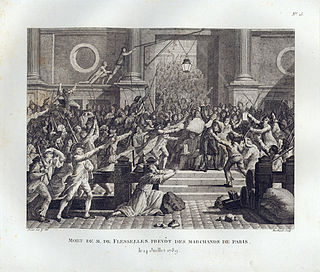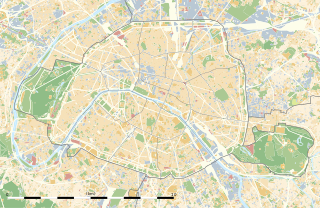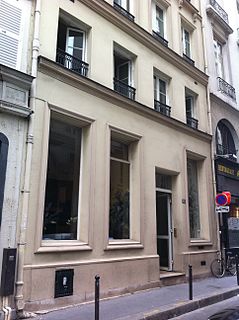
The Tivoli gardens of Paris were amusement parks located near the current site of the Saint-Lazare station, named after the gardens of the Villa d'Este in Tivoli near Rome. There were several such gardens in succession between 1795-1842, none of which are remaining today.

Lanterne is a French word designating a lantern or lamp post. The word, or the slogan "À la lanterne!" gained special meaning and status in Paris and France during the early phase of the French Revolution, from the summer of 1789. Lamp posts served as an instrument to mobs to perform extemporised lynchings and executions in the streets of Paris during the revolution when the people of Paris occasionally hanged officials and aristocrats from the lamp posts. The English equivalent would be "String Them Up!" (British) or "Hang 'Em High!"(American)

Le Sphinx was a maison close (brothel) in Paris in the 1930s and 1940s. Along with the "Le Chabanais" and "One-Two-Two" it was considered one of the most luxurious and famous Parisian brothels.

Rue des Francs-Bourgeois is one of the longer and more interesting streets in the Marais district of Paris, France.

The Goutte d'Or is a neighbourhood in Paris, located in the 18th arrondissement of Paris.

Le Chabanais was one of the best known and most luxurious brothels in Paris, operating near the Louvre at 12 rue Chabanais from 1878 until 1946, when brothels were outlawed in France. It was founded by the Irish-born Madame Kelly, who was closely acquainted with several members at the Jockey-Club de Paris. Among the habituées were Albert, Prince of Wales ; Toulouse-Lautrec; Cary Grant; Humphrey Bogart, Mae West and diplomatic guests of the French government.

The 1st arrondissement of Lyon, France is one of the nine arrondissements of the City of Lyon. It is located below the hill of Croix-Rousse and on the north part of the Presqu'île formed by the Saône and the Rhône, the two rivers in Lyon

The Rue Lanterne is one of the oldest streets of Lyon created the Middle Ages, which is located in the 1st arrondissement of Lyon. It begins after the rue d'Algérie and ends against a facade of the rue Longue.

Marguerite Gourdan, née Marguerite Alexandrine Ernestine Stock was a French brothel owner and procurer in 18th-century Paris. Her brothel was the most exclusive in Paris during that age, and Gourdan was arguably the most famous of her profession.

The Rue Radziwill is a street in the 1st arrondissement of Paris. It starts at 1 rue des Petits-Champs and ends in a dead end. It was named after Polish Prince, politician and one of the wealthiest men in Europe Karol Stanisław Radziwiłł.

During the Second French Empire, the reign of Emperor Napoleon III (1852–1870), Paris was the largest city in continental Europe and a leading center for finance, commerce, fashion, and the arts. The population of the city grew dramatically, from about one million persons to two million, partially because the city was greatly enlarged through the annexation of eleven surrounding communes. These additions, which led to the creation of eight new arrondissements, brought the city to its present boundaries. In 1853, Napoleon III and his prefect of the Seine, Georges-Eugene Haussmann, began a massive public works project, constructing new boulevards and parks, theaters, markets and monuments, a project he continued seventeen years until his downfall.
Loi Marthe Richard of April 13, 1946 abolished the regime of regulated prostitution in France that had been in force since 1804. It required the closure of brothels. The law bears the name of Marthe Richard, who was a municipal councillor of Paris but not a parliamentary representative.

La Fleur blanche was a famous maison close (brothel) in the city of Paris, located at 6 rue des Moulins in the 1st Arrondissement. The property was also known as rue des Moulins and was famous for its torture room.

The One-Two-Two was one of the most luxurious and illustrious brothels of Paris in the 1930s and 1940s. The name was taken from the address, 122 Rue de Provence, 8th arrondissement of Paris. The numbers were translated into English to ensure that foreign tourists would be able to find the brothel and as a password for French people.

The Aux Belles Poules was a well-known Parisian maison close (brothel), established at 32-34 Rue Blondel in the 2nd Arrondissement.

L'Étoile de Kléber was a maison close (brothel) in Paris. It obtained notoriety for continuing to run after the 1946 Loi Marthe Richard ban on brothels. It continued its operations for a while in secret.

Le Fourcy was the most famous mass brothel of Paris, a so-called Maison d'abattage. It was located in the Saint-Paul district in the 4th arrondissement at 10 rue de Fourcy, and was notorious for treating its women very badly. In his book Le Petit Simonin, novelist Albert Simonin wrote:
"The Fourcy in the district of Saint-Paul, the most famous of the Paris slaughter houses, demanded 5.50 francs per session. "Five francs per lady and room," as if it were a chorus's chorus, who goes to the room? "The ten sous, which were asked for as a supplement to the five francs, is not a tip, but a tariff for the towel attracted so many customers on working days that some ladies who were not too bad, were anything but unemployed and able to cope with seventy sessions."
The authorities of medieval Paris attempted to confine prostitution to a particular district. Louis IX (1226–1270) designated nine streets in the Beaubourg Quartier where it would be permitted. In the early part of the 19th century, state-controlled legal brothels started to appear in several French cities. By law, they had to be run by a woman and their external appearance had to be discreet. The maisons were required to light a red lantern when they were open and the prostitutes were only permitted to leave the maisons on certain days and only if accompanied by its head. By 1810, Paris alone had 180 officially approved brothels.
Prostitution in Paris, both street prostitution and prostitution from dedicated facilities has a long history but also its own modernity in the French capital. Prostitutes are mostly women but also include transgender people and men.

The history of prostitution in France has similarities with the history of prostitution in other countries in Europe, namely a succession of periods of tolerance and repression, but with certain distinct features such as a relatively long period of tolerance of brothels.















